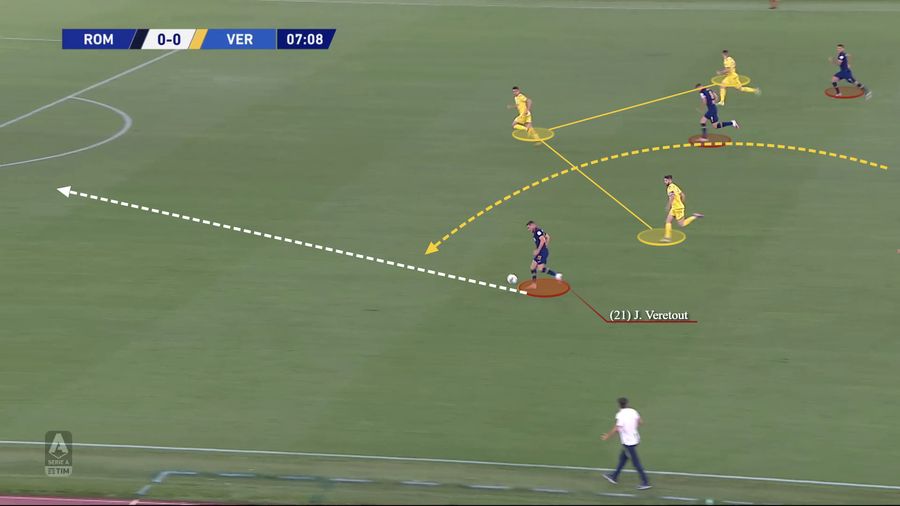

Vital win against Verona
In a tense, entertaining evening at the Stadio Olimpico, Roma overcame Ivan Juric's excellent Hellas Verona side by a tight 2-1 scoreline.
Unquestionably one of the most difficult teams to play against in Serie A due to their slick attacking play and intense pressing, Paulo Fonseca's game plan was crucial towards their success against the well-drilled Gialloblu.
Having clearly done his homework on his opponents and content to cede possession, allowing the away team to enjoy 60% of possession, Roma were able to control proceedings pretty well from their 3-4-2-1/3-4-3 shape that mirrored that of their adversaries.
Restricting Verona to just one shot on target and five overall and enjoying the upper hand on Expected Goals, 1.94 to 1.26, Roma were good value for the win.
With goals from the irrepressible Jordan Veretout and Edin Dzeko propelling the Giallorossi to victory, the Portuguese tactician was full of praise for his determined side.
“I really liked the attitude of pretty much all the players tonight," he stated.
“It’s always tough to play against sides like Verona, but I think today we won and we played well. We could have killed the game off sooner, we had six or seven chances to score goals.
“Defensively we were pretty much always high up the pitch and Pau Lopez did not have to do much, although it wasn’t straightforward. None of the other big sides have been able to dictate the play against them this season, but we were never really at great risk and we found a lot of space behind their defence.”
Pressing structure bears fruit
Seeing as Verona love to build out from the back with purpose and intent, how Roma deployed a neat man marking high pressing plan worked effectively to limit their success.
Working well as a collective unit and putting in a quality shift, this was a key component towards them restricting Verona's usually free flowing passing game.
To start with, the three attackers in Dzeko, Henrikh Mkhitaryan and Lorenzo Pellegrini would be oriented towards Verona's back three. The wingbacks would then step out to the opposition wingbacks while Veretout and Amadou Diawara would typically mark Verona's central midfield duo of Miguel Veloso and Sofyan Amrabat.
Roma's back three of Gianluca Mancini, Roger Ibanez and Aleksandar Kolarov would be in charge of marking the away side's front trio.
It was also interesting to note how they would cohesively shift over to the ball near side as a unit, to condense the pitch, and how the ball far winger would tuck in and help the central mids mark Verona's classy pairing in this zone or any dropping movements from the three most advanced players.
Bypassing the press
Knowing Verona would press high in their customarily aggressive man-on-man pressing scheme, Fonseca shrewdly instructed his team not to play out from the back and instead go long to Dzeko.
Using the Bosnian's aerial prowess and strength, he served as an ideal outlet to bypass the press. Roma's two attacking midfielders, Pellegrini and Mkhitaryan (and even the ball-near wing-back and a central midfielder), would then be positioned nearby to win the second balls.
From this coordinated structure Dzeko had many options around him, as Roma often created a 4v3 or 3v2 overload around Dzeko to enhance their chances of regaining the ball high so they could immediately attack Verona with players receiving in advantageous forward facing positions.
Whether it be finding teammates with flick-ons, knockdowns or with his feet or chest, Dzeko was integral to the success of the tactic, which Fonseca deserved immense credit for implementing it so astutely.
Moreover, the fact Roma's average pass length of 22.08 metres was over two metres longer than their season average and their long pass percentage rate was up eight percent demonstrated their distinct approach.
Fast transitions lethal
Despite only enjoying 40% possession, it was impressive how Roma still generated 19 shots against Verona. Undoubtedly their directness and clinical counter attacks were crucial towards this, for they broke with speed, power and intensity as soon as they won back possession.
Seeing as the front three were pressing Verona's back three, this meant when Roma regained possession they had three outlets to find and could regularly generate favourable 5v4, 4v4 and 3v3s in transition.
By then factoring in how Veretout and the wing-backs would also relish bombing forward, this punctuated their danger. Persistently causing marking dilemmas for the backpedaling, under pressure Verona backline, in combination with how they'd stretch and run quality routes to either be in an option or draw markers away, this saw their threat heightened.
How Roma overcame Verona's counterpressing was another feature, for Juric's men are usually slick operators at winning the ball back quickly to prevent such counters, with the Giallorossi's compact stopping shape ensuring they were well placed to receive passes once the ball was won.
It was little wonder then that the catalyst for Roma winning the penalty that saw them open the scoring arose from a wicked transition, where Veretout's damaging run breathed life into the attack.

 Tickets
Tickets
 Shop
Shop












































